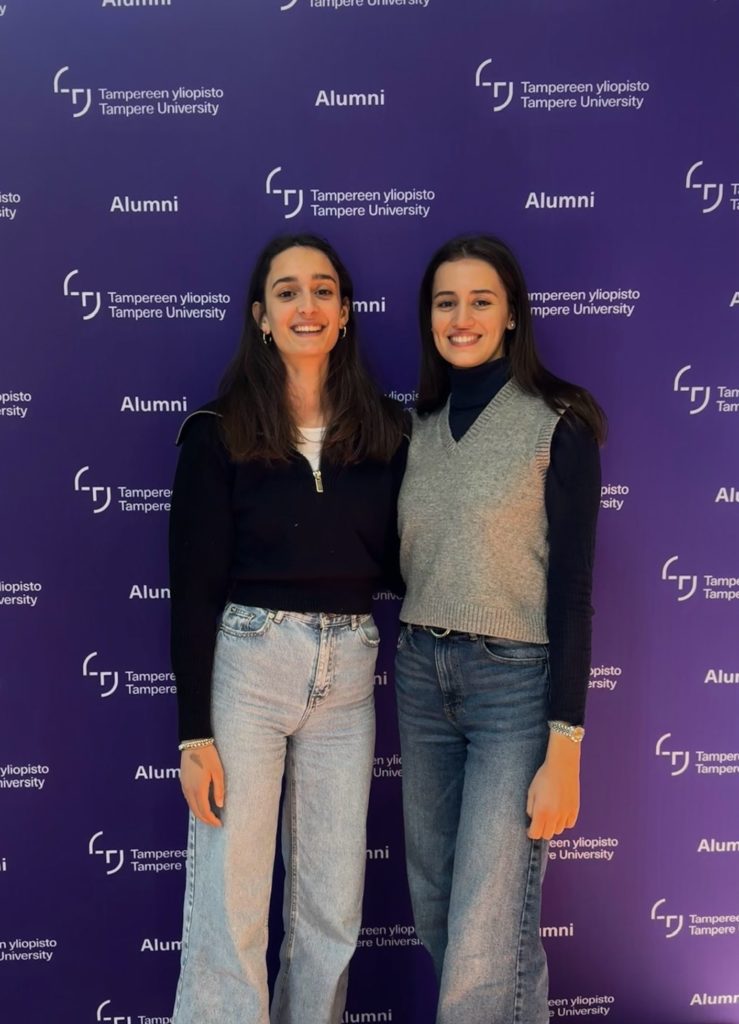EU FET Open PRIME project brings together partners from across Europe into a strong multi-disciplinary team. Today we meet two junior scientists working on the PRIME project at Tampere University in Finland, who are actually final year students from another university partner of the consortium – The University of Ferrara in Italy – a terrific demonstration of collaboration between the PRIME consortium of partners.
Claudia Maccatrozzo and Elisabetta Urban are in the final year of their master’s degree in Pharmaceutical Chemistry and Technologies in The University of Ferrara (Italy). They arrived at Tampere University in spring 2024 to participate as interns in the PRIME project, with the main aim of writing their master’s degree theses. The collaboration has come about with thanks to the efforts of both universities, with significant thanks to Prof. Pasi Kallio from Tampere University and Prof. Silvia Zucchini from the University of Ferrara.

What are you currently working on in PRIME and what are your aims?
One of the main tasks of the PRIME project is to develop an encapsulating, porous, tubular, and implantable membrane to house engineered ARPE-19 cells which produce Glial Cell Line-Derived Neurotrophic Factor (GDNF) constantly.
Elisabetta: ‘’The choice of the encapsulation material was between two different types of polymers: polyether sulphone (PES) and polydimethylsiloxane (PDMS). Both, Claudia and I, work on the maintenance of the GDNF-producing ARPE-19 cells. At least once a week we prepare a cell suspension to fill both the PES and PDMS tubes. One of the aims of my thesis is to develop a fabrication method for the PDMS tubes and ensure the porousness of the material for example for the GDNF efflux.’’
Claudia: ‘’My main task in the project is to analyse the release of the GDNF by engineered ARPE-19 cells. These cells have been generated in Italy and shipped here in Tampere. In particular, my main aim is to find out whether the cells capable of producing the GDNF, placed inside a porous and hollow PES tube, can release the GDNF and if the GNDF can cross the membrane of the PES tube through the pores. Once this is confirmed, I plan to include neurons in my cell culture and study the epileptic seizure suppression after the GDNF releasement in vitro.’’
Have you had any particular achievements/breakthroughs to date?
Claudia: ‘’Thus far, having learnt how to culture the cells, I have started to analyse the GDNF production by the cells. From the first analysis, we have been able to understand that the GDNF-ARPE-19 cells are surviving very well in our cell culture environment and above all, that the production of GNDF is very high. We are extremely satisfied with these results.’’
Elisabetta: ‘’PDMS tubes have one major difference from PES tubes: they are transparent. This allowed us to test and improve the technique of filling the tubes with the cells. For instance, we were able to examine how to fill the tubes properly without causing any air bubbles, and also to check the state of the cells inside the tubes under an optical microscope. ’’
What impact will working on PRIME have on your career / what opportunities will it extend?
Claudia: ‘’This is the first time I have been both abroad and in a research group of this magnitude, so I am really hopeful that it will be a valuable starting point for my future career in general. I’m definitely acquiring many skills and soft skills that I didn’t have before and that will surely be useful for me to work in any other research group and work environment. In my opinion, having this type of project as part of my curriculum will aid me in finding some exciting and stimulating jobs, such as this.’’
Elisabetta: ‘’I find this project very inspiring and fascinating, firstly because it involves so many universities: this allows me to compare the techniques and research methods of both my home university and Tampere University. It is also a wonderful opportunity to compare myself with so many different researchers in different research groups: this will certainly clear my future a bit more, for example, whether research can be my path. For now, I have realized that this profession is very creative and offers new opportunities every day, which I find very exciting.’’
What excites you the most about this project?
Claudia: ‘’One of the things that excites me the most in this project is knowing that I’m studying and designing something that could be useful for epileptic patients. I know how limiting this disease can be, so feeling somehow useful for these people, even in a small way, brings me great pride and satisfaction.
I am convinced that the project involving people from different fields is one of its strengths. The constant comparison between different ideas and cultures is always a very engaging experience, even in front of a cup of tea in the coffee room.’’
Elisabetta: ‘’As soon as our professor from the University of Ferrara explained the PRIME project to us, I immediately found it interesting and truly innovative in every way.
The most interesting thing for me is the collaboration between different universities from all over Europe to achieve a common goal. The thing that excites me the most is definitely the fact that I can give my contribution to this project. Even though I certainly don’t have the background that so many people who participate in this project have, I still feel like I am part of this project and therefore part of this vast group. ‘’

Elisabetta Urban (left) and Claudia Maccatrozzo (right)
Tampere University is one of several multi-disciplinary European partners working on the PRIME project, funded by the European Commission’s Horizon 2020 Research and Innovation programme. The PRIME project aims to prevent epileptic seizures by developing autonomous implantable living cell systems for the brain.
Led by Walton Institute at South East Technological University, EU FET OPEN PRIME project’s consortium of European partners is made up of Tampere University Finland, Università degli Studi di Ferrara Italy, EPOS-IASIS Cyprus, Aarhus University Denmark, omiics Denmark and Royal College of Surgeons in Ireland (RCSI) in Ireland.







